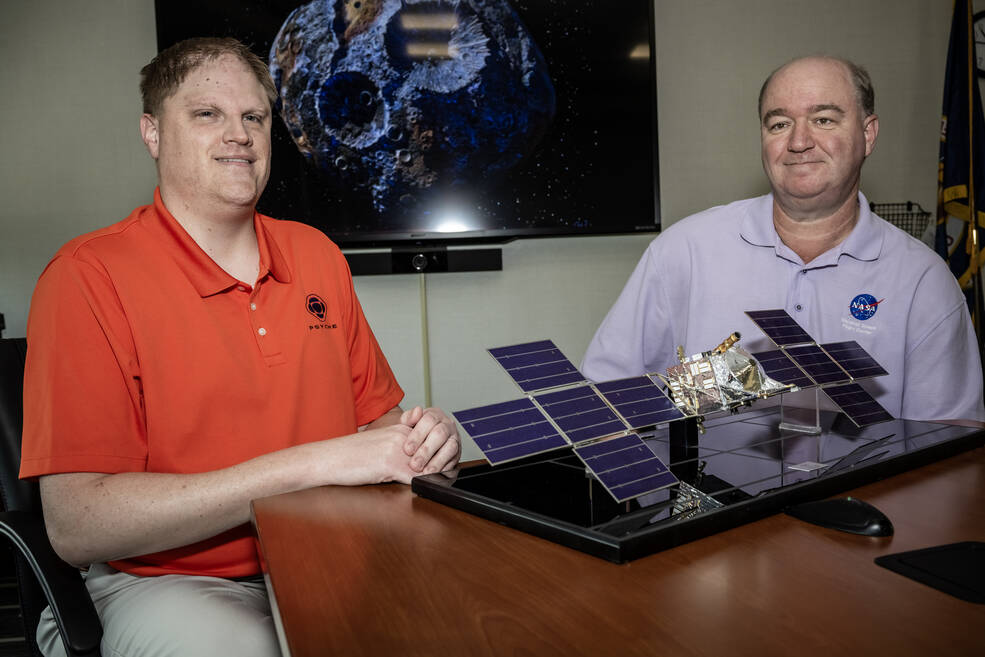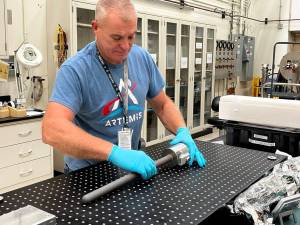Countdown to Psyche: Marshall Aids Preparations for Asteroid Mission, Key Technology Payload
By Rick Smith When the Psyche spacecraft lifts off Oct. 5 to rendezvous with a distant, metal-rich asteroid – and test an innovative new communications system on the way – management teams at NASA’s Marshall Space Flight Center will be watching keenly. Psyche is the 14th planetary exploration mission in NASA’s Discovery program, which is managed for […]

5 min read
Countdown to Psyche: Marshall Aids Preparations for Asteroid Mission, Key Technology Payload
By Rick Smith
When the Psyche spacecraft lifts off Oct. 5 to rendezvous with a distant, metal-rich asteroid – and test an innovative new communications system on the way – management teams at NASA’s Marshall Space Flight Center will be watching keenly.
Psyche is the 14th planetary exploration mission in NASA’s Discovery program, which is managed for the agency by Marshall – as is the TDM (Technology Demonstration Missions) program, which funds the DSOC (Deep Space Optical Communications) project.

“We ensure the project teams have all the resources they need to execute the project, monitor costs and schedules to keep the project on track and on time, and work closely with the payload and launch teams throughout the flight mission,” said Brad Zavodsky, Psyche mission manager in Marshall’s Planetary Missions Program Office.
Joel Robinson, DSOC mission manager at Marshall, concurs. He and Zavodsky serve as “conduits,” he said, between directorate-level technology and science leadership at NASA Headquarters and the Psyche and DSOC project leadership – both of which, serendipitously, are managed at NASA’s Jet Propulsion Laboratory.
The program office teams at Marshall include program planning and control personnel, independent technical authorities, and procurement and acquisition specialists. These technical experts provide the Psyche and DSOC missions with all necessary guidance and direction throughout their respective development and programmatic life cycles.
“That means a number of presentations, weekly telecons, and periodic reviews,” Robinson said, “but it’s all worth it as we count down to launch. All that oversight helps facilitate delivery of a robust payload – one that’s ready for launch and ready to extend humanity’s reach into the solar system.”
Led by principal investigator Dr. Lindy Elkins-Tanton at Arizona State University, Psyche is set to be lofted to space on a SpaceX Falcon Heavy – the first interplanetary launch of that rocket – from NASA’s Kennedy Space Center at 9:34 a.m. CDT on Oct. 5.
Powered by solar electric propulsion, Psyche’s flight to the asteroid will take six years; it will reach its destination in 2029 and begin a 26-month period of scheduled scientific observations, gathering images and data to shed new light on the asteroid’s history and composition.
The Psyche asteroid, orbiting the Sun in the asteroid belt between Mars and Jupiter, measures roughly 173 miles at its widest point. Researchers are keen to determine whether it may have been the core of a planetesimal, part of an early planet.
“We know a good deal about Earth’s core, but we can’t study it directly because of its depth below the crust and mantle,” Zavodsky said. “Investigating Psyche is perhaps the closest we can come. Studying its composition and structure is an exciting opportunity to learn more about such objects in space – and perhaps a little something about our own planet as well.”
Should the Psyche spacecraft encounter challenges during flight, Zavodsky’s team will assist mission managers at JPL and Arizona State University, for whom Marshall oversees the project management and principal investigator contracts.
“We’ll maintain direct engagement with the project team and NASA decision-making authorities,” he said. “Should an issue arise, the project will be prepared to stand up anomaly response teams to understand and resolve those challenges. Our program office will support that effort as needed.”
Meanwhile, the DSOC technology demonstrator is set to pursue its own mission, sending and receiving test data from Earth using a near-invisible infrared laser and sensitive photon-counting camera. It will mark NASA’s farthest-ever test of high-bandwidth optical communications – paving the way for broadband communications when NASA sends astronauts to Mars.
“We’re tackling the twin issues of bandwidth and transmission rate to expand and refine our data-gathering ability from missions beyond the Moon,” Robinson said. “We can’t transmit data faster than the speed of light, but we can do far more with advanced optical systems of the same size and power requirements as traditional radio systems.”
Building on the Lunar Laser Communications Demonstration mission flown on the International Space Station in 2013 and the Laser Communications Relay Demonstration, launched to geostationary orbit above Earth in 2021, the DSOC effort is the first to experiment with ultra-long-range, laser-based communications.
“It’s exciting to take optical communications capabilities into deep space for the first time,” Robinson said.
DSOC could deliver 10 to 100 times the data current radio systems are capable of transmitting, with far greater precision and clarity.

Joel Robinson
DSOC mission manager at Marshall
DSOC will test its optical transmission capabilities at and beyond a range of 1 astronomical unit, which is about 93 million miles – or the distance from the Sun to Earth. Psyche proves to be the perfect means to that end, requiring a gravity-assisting pass around the Sun in order to accelerate on its journey to the Psyche asteroid.
JPL laser researchers in California will send optical data to the DSOC payload during pre-conjunction – the period before the spacecraft is blocked by the Sun itself – and again during post-conjunction.
Smith, a Manufacturing Technical Solutions employee, supports the Marshall Office of Communications.
Share
Details
Related Terms
What's Your Reaction?















































